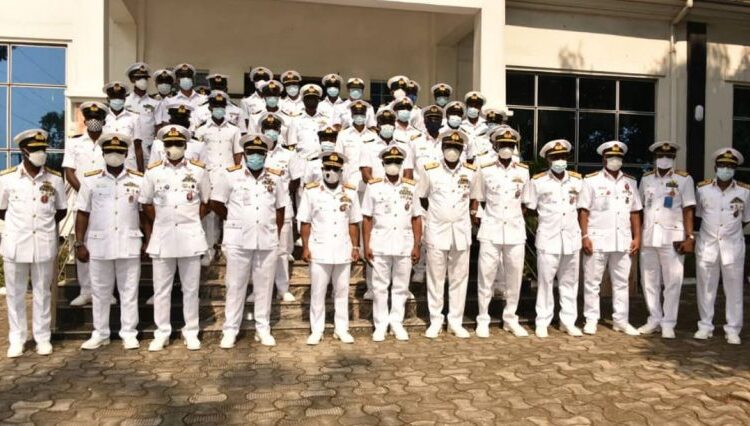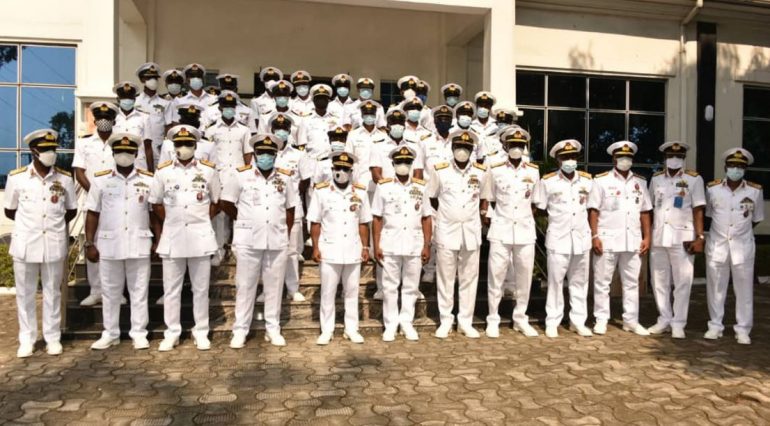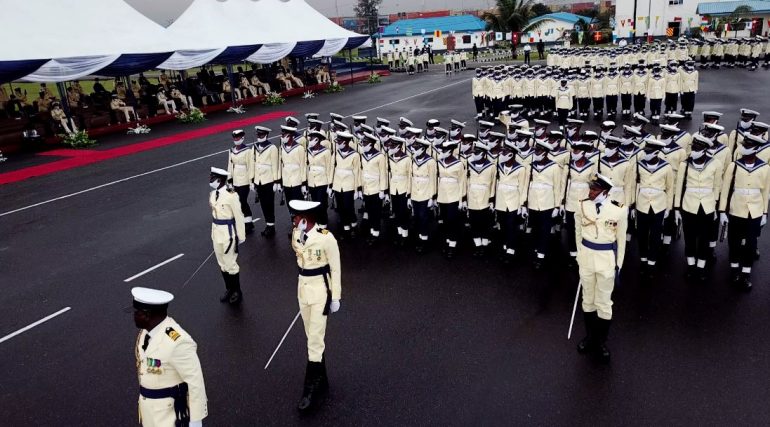
Every branch of the Nigerian Armed Forces has its own ranks and salary structure, and the Nigerian Navy is not an exception. I am certain that you want to know how much Nigerian navy officers get every month as salary.
If you are looking for a comprehensive article that will offer you all of the information you need about the Nigerian Navy Ranks, Symbols, and Salary Structures? Then you’ve come to the correct place because this blog post offers all the details you’ll need about Nigerian Navy Ranks and Salary Structures.
The purpose of this article is to give you the required information concerning the monthly salaries of the commission and non-commissioned officers in the Nigerian Navy. Maybe you are doing research to understand the ranks and roles in the force or you are interested in joining the Nigerian Navy, this post gives you relevant information, which will be vital for you.
If you are looking for an opportunity to get recruited into the Nigerian Navy, you need to know what you are getting yourself involved in. Maybe it is your desire to become a member of the Nigerian Navy, it is imperative to inform you that the salary structure of the Nigerian Navy is not too different from that of the Nigerian Airforce and Nigerian Army. What this means is that as a naval officer, you get according to your rank. Hence, the higher you rank, the higher your salary.
Since the news broke out that the Nigerian Navy recruitment has begun, many people have been looking for how to apply. Apart from the financial benefits you get, there are other advantages of being an officer in the Nigerian Navy. First, you will be accorded respect and regard everywhere you go because you are putting your life on the life to protect the pride and territorial integrity of your country.
We cannot see the salary structure of an institution without knowing what they do. Before we get started, let’s see a brief history and description of the Nigerian Navy.
About the Nigerian Navy

The Nigerian Navy (NN) is the marine branch of the Nigerian Armed Forces. In case you don’t know, the Nigerian Armed Forces consist of three arms which include the Nigerian Air Force, Nigerian Navy, and Nigerian Army.
The Nigerian Navy is tasked with the sole responsibility of protecting Nigeria’s water territory. It was founded in 1914 as Nigerian Marine before it was renamed to the Nigerian Naval Force.
The Nigerian Marine was split into various departments, one of which is the Nigerian Navy. Other departments created from this division include the Inland Waterways Department and the Nigerian Ports Authority.
The Nigerian Navy, which includes the Coast Guard, is regarded as one of the largest on the African continent, in terms of technicality and workforce. They have more than tens of thousands of officers and are still recruiting more members. Each member of the Nigerian Navy is assigned to a specific rank.
The Nigerian Navy was set up to enlist and train recruits, and also provide the necessary system for the administration of naval activities. In the initial stage, the force was trained by the Royal Navy Officers. So, the officers in the Navy consist mostly of Royal Navy Officers as well as ex-servicemen from the defunct Nigerian Marine.
Due to the dearth of skilled naval officers, the Nigerian Navy hosted its first-ever training program for prospective officers called the “HMNS QUORRA”. It was a six-month program that began on November 1, 1957. During this period, over sixty people completed the basic seamanship program.
The progress of the Nigerian Navy spurred a metamorphosis as the organization was transformed into a full-fledged Navy. The Queen of England in the person of Queen Elizabeth permitted them to use the title “Royal Nigerian Navy” in July 1959. After Nigeria became a republic in 1963, the force was renamed to “Nigerian Navy.”
The Nigerian Navy is divided into 5 branches, 9 commands, and various units. The headquarters of the Nigerian Navy is in Abuja; however, you can find operational commands of the force in Lagos, Calabar, and Bayelsa state. The locations of the Nigerian Navy commands are listed below:
- Western Naval Command, Lagos State.
- Naval Training Command, Apapa, Lagos State.
- Eastern Naval Command, Calabar, Cross River State.
- Logistics Commands, Oghara, Delta State.
- Central Naval Command, Yenagoa, Bayelsa State.

What are the Functions of the Nigerian Navy?
Apart from safeguarding the water territories of the Nigerian nation, other duties and responsibilities of the Nigerian Navy include:
- Providing ferrying services when needed.
- Protecting Nigerian seas, oceans, and other water territories in the country.
- Port and harbor administration within the Nigerian territory.
- Implementing all maritime laws (national and international inclusive).
- Drainage channel dredging.
- Enforcing the government rules on fishing, water pollution, immigration, sea transport and other areas.
Nigerian Navy Ranks and Salary Structure in 2022
Currently, the Chief of Naval Staff is the highest position in the Nigerian Army. The Chief of Naval Staff controls and directs the activities and affairs of the navy, and is accountable to the Commander-in-Chief of the Armed Forces, which is the Nigerian President. At the time of writing, the Chief of Naval Staff in Nigeria is Vice Admiral Awwal Zubairu Gambo.
It is the Chief of Naval Staff’s responsibility to report to the Chief of Defence Staff, who then reports to the Minister of Defense, and finally to the Commander-in-Chief of the Armed Forces Forces, also known as the President.
The Nigerian Navy salary structure is somewhat similar to the Consolidated Tertiary Institution Salary Structure (CONTISS) for university lecturers and the Consolidated Nigerian Police Force’s Police Salary Structure (CONPOSS).
As in other professions in the country, the salaries of officers in the Nigerian Navy are paid with respect to their rank or position. That is, a senior naval officer will receive a higher salary than a junior officer. Officers can be promoted sequentially, that is from a particular rank to the next rank) or can be promoted exponentially (skipping one or more ranks to promote a naval officer to a higher position).
The Nigerian Navy rank and salary structure is further divided into two categories namely:
- Commissioned Officers.
- Non-commissioned Officers.
Nigerian Navy Ranks For Commissioned Officers
Officers who joined the Nigerian Navy as graduates or through the Nigerian Defence Academy in Kaduna State. They are known as Nigerian Navy Commissioned Officers. Although some are university graduates, others would have joined the Nigerian Navy through the Direct Short Service Commission.
Commissioned officers are entitled to receive higher salaries than non-commissioned officers. This cadre is divided into twelve ranks. New intakes and graduates from the Nigeria Defense Academy start with the Midshipman position before working their way to the top.
Before being commissioned into the Nigerian Navy, individuals must complete six months of military training. Those who enlist through the Nigerian Defence Academy (NDA) receive both academic and military training over the course of five years. They are referred to as normal officers.
Here is a hierarchical list of the commissioned cadre ranks in the Nigerian Navy.
- Admiral of the Fleet
- Admiral
- Vice-Admiral
- Rear Admiral
- Commodore
- Captain
- Commander
- Lieutenant Commander
- Lieutenant
- Sub-Lieutenant
- Acting Sub-Lieutenant
- Mid-Shipman
Nigerian Navy Ranks For Non-Commissioned Officers
Non-Commissioned Officers in the Nigerian Navy are those who enlisted in the Nigerian Navy after the advertised recruitment program. Some of the non-commissioned officers are SSCE certificate holders. They are trained for six months before joining the Nigerian Navy as troops.
The non-commissioned offers are usually at the bottom of the organizational chart in the Nigerian Navy. So, their pay is usually low compared to that of the Commissioned officers. However, their pay rises as they are promoted.
Let us now look at the Nigerian Navy’s Ranks and Salary Structure.
- Warrant Chief Petty Officer
- Chief Petty Officer
- Petty Officer
- Leading Rating
- Able Rating
- Ordinary Rating
- Trainee
However, from the top to the lowest, this article lists the annual incomes of both commissioned and non-commissioned officers, senior personnel, and junior officers.
Nigerian Navy Ranks For Commissioned Officers And Salary
- Admiral N1,728,293 monthly
- Vice-Admiral N1,496,491 as monthly
- Rear Admiral N1,376,353 as monthly
- Commodore N744,556 monthly salary
- Captain Commander N459,054 monthly
- Lieutenant Commander N293,454 as monthly
- Sub-Lieutenant N219,450 monthly
- Midshipman N188,189 monthly
Nigerian Navy Ranks For Non-Commissioned And Salary
- Warrant Chief Petty Officer N165,657
- Chief Petty Officer N111,574 monthly
- Petty Officer N90,251 monthly
- Leading Seaman N75,654 monthly
- Able Seaman N65,852 monthly
- Seaman N57,652 monthly
- Ordinary Seaman N53,852 monthly
- Trainee N10,227 monthly
It is worthy to note that the trainees are not paid until they have completed their training. They get paid after they have been enlisted and recruited into the force, and that is when they are recognized as naval officers.
Nigerian Navy Ranks In Detail
Continue reading to learn more about the various ranks of the Nigerian Navy.
- Mid-Shipman: The lowest rank for commissioned officers in the Nigerian Navy is this one. It is equal to the Pilot Officer position in the Nigerian Air Force and the Second Lieutenant rank in the Nigerian Army.
- Lieutenant Commander: Lieutenant Commander is below Sub-Lieutenant, and Lieutenant Commander is above Sub-Lieutenant. Lieutenant and Flying Officer are equivalent positions in the Nigerian Army and Nigerian Air Force.
- Lieutenant: In the Nigerian Army, this is equivalent to Captain, and in the Nigerian Air Force, it is equivalent to Flight Lieutenant.
- Rear-admiral: This is the rank that follows Vice Admiral but precedes Commodore. 2-star officers are officers holding the rank of two stars. Rear admirals, commonly known as flag officers, are the lowest-ranking officers in the “Admiralty ranks.”
- Vice-admiral: This title is equivalent to Lieutenant General in the Nigerian Army and Air Vice Marshal in the Nigerian Air Force. It’s a rank that sits halfway between rear admiral and admiral. Officers of this rank are known as 3-star officers.
- Admiral (Adm): The only post above it is of a more honorary nature, hence this is the highest title in the Nigerian Navy. The post is above and below Vice Admiral of the Fleet. He is the equivalent of General in the Nigerian Army and Air Chief Marshal in the Nigerian Air Force.
- Admiral of the Fleet: is the highest rank in the Nigerian Navy. It is rarely awarded because it is more of an honorary position. It is the equivalent of Marshal of the Nigerian Air Force in the Nigerian Air Force and Field Marshal in the Nigerian Army.
Prestige of the Nigerian Navy
For decades, the Nigerian military has relied on foreign nations for weaponry and to fuel a thriving defense sector. Nigeria has recently entered the industry of building its own warships.
The Nigerian Navy, in particular, has designed and built some ‘Seaward Defense Boats’ (SUB). The ‘Seaward Defense Boat’ (SUB) is a mid-shore patrol boat that is less capable than a coastal patrol boat but more capable than a deep ocean-going ship.
The Nigerian Navy’s warship-building capability demonstrates how far we can go as a nation if we believe in our capabilities.
How To Join The Nigerian Navy With O’Level
If you have any O’level results, maybe your OND, NCE, NAPTEB, WAEC, GCE, and SSCE, you can join the Nigerian Navy if you meet certain conditions. Applicants who are joining the Navy with these certificates will join the cadre of non-commissioned officers.
Without further ado, the following are the requirements and conditions you must meet to become a Nigerian Navy officer with your SSCE, NCD, and OND certificates:
- Have any of the certificates (SSCE, NCD, and OND) or their equivalents.
- Aged between 18 and 22 years at the time of application.
- Be a Nigerian by birth.
- Applicants should not have any children and must not be married as of the time of application.
- You cannot apply if you have any of the following health problems (ear problem, flat foot, bow leg, K-leg, stammering, short-sightedness, previous orthopedic surgery, fractures, and other natural disabilities).
- Have no previous criminal record or convictions by a law court.
- Applicants must print a consent form, which will be signed by their parents or guardians.
- Applicants must print a Local Government Attestation Form.
How To Join The Nigerian Navy as a Graduate
If you are a university graduate or you graduated from any tertiary institution with BSc, HND, or their equivalent, you can join the Nigerian Navy as a graduate. Applicants must meet the following requirements below:
- Be Nigerians by birth.
- Aged between 18 and 28 years at the time of application.
- Be physically and medically fit.
- Have no previous criminal record or convictions by a law court.
- Female applicants should be at least 1.65 meters tall while the male should be at least 1.68 meters tall.
- Provide a BSc or HND certificate, or their equivalents.
- Applicants must provide 2 referees to attest to their character and integrity.
If you meet all of these requirements, then you are eligible to become a member of the Nigerian Army. Visit the recruitment website (www.joinnigeriannavy.com) to complete your application.

How long is Nigeria Navy training?
The training takes around 9 months to finish, and those who are accepted will be trained so that they may contribute to the NN’s activities.
If you want the Nigerian navy to approve your application, you must carefully follow the application process. It all starts with properly filling out the application form.
If you do not complete this correctly, you may lose your chance to participate in the Nigerian Navy Short Service Course. This article will offer you a heads-up on some of the factors that will decide your success while applying for the program.
What is the minimum age requirement for the Nigerian Navy?
At the time of application, applicants must be between the ages of 18 and 22. For individuals with better qualifications, 24 years is appropriate. Applicants must have been born in Nigeria.
Is it possible to join the Navy through WAEC?
Applicants must have one or more of the following educational credentials. Waec City and Guilds or London City and Guilds/Ordinary National Diploma/West African certificate/Senior secondary school certificate/General Certificate of Education Ordinary Level/Waec City and Guilds or London City and Guilds
How can I join the Nigerian Navy?
If you want to apply for the Nigerian Navy Recruitment 2022, visit the Nigerian Navy website and fill out the application form as well as upload the required documents.
Conclusion
Based on the salary structure of the Nigerian Navy, we can say that the Nigerian Navy is one of the highest-paying institutions in Nigeria. Asides from the salaries, naval officers receive other benefits such as travel allowances, especially when they are on oversea training or deployed on special assignments.




